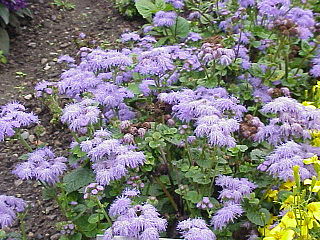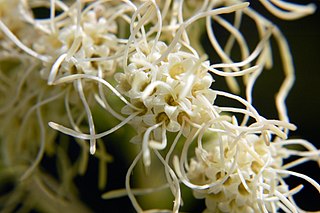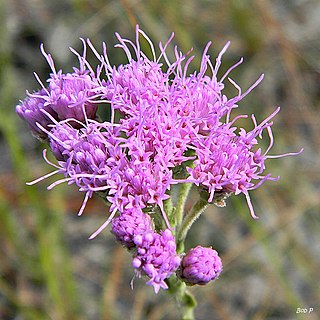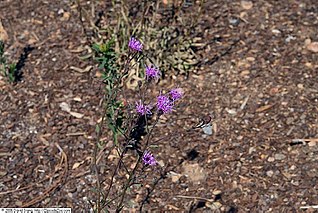
Liatris is a genus of flowering plants in the boneset tribe within the sunflower family native to North America. Its most common name is blazing star. Some species are used as ornamental plants, sometimes in flower bouquets.

Eupatorieae is a tribe of over 2000 species of plants in the aster family. Most of the species are native to tropical, subtropical, and warm temperate areas of the Americas, but some are found elsewhere. Well-known members are Stevia rebaudiana, a number of medicinal plants (Eupatorium), and a variety of late summer to autumn blooming garden flowers, including Ageratum (flossflower), Conoclinium (mistflower), and Liatris.

Mikania is a genus of about 450 species in the Eupatorieae (boneset) tribe within the Asteraceae (sunflower) family.

Chrysogonum virginianum, the golden-knee, green and gold, or goldenstar, is a North American species of plants in the sunflower family. It is native to the eastern United States from New York State and Rhode Island south to Louisiana and the Florida Panhandle.

Iva is a genus of wind-pollinated plants in the daisy family, described as a genus by Linnaeus in 1753. Plants of this genus are known generally as marsh elders. The genus is native to North America.

Erigeron strigosus is a species of flowering plant in the daisy family Asteraceae known by the common names prairie fleabane, common eastern fleabane, and daisy fleabane.
Hartwrightia is a genus of North American flowering plants in the tribe Eupatorieae of the sunflower family. The genus contains a single species, Hartwrightia floridana, native to the US states of Georgia and Florida. The species is sometimes referred to by the common name Florida hartwrightia.

Bigelowia is a genus of North American flowering plants in the daisy family, native to the United States.
Trilisa is a genus of flowering plants in the boneset tribe within the daisy family.

Adaina bipunctatus is a moth of the family Pterophoridae. It is found in the United States, including Florida and Mississippi. It has also been recorded from Trinidad, the West Indies, Brazil and Ecuador.

Balduina uniflora is a North American species of plants in the sunflower family. It is native to the southeastern United States. It is the type species of Genus Balduina.
Berlandiera pumila is a North American species of flowering plant in the sunflower family. It is native to the southeastern and south-central United States.

Brickellia eupatorioides, or false boneset, is a North American species of flowering plants in the daisy family. It is widespread in Mexico from Chihuahua to Oaxaca, and in all regions of the contiguous United States except New England, New York, and the West Coast.
Brickellia lemmonii, or Lemmon's brickellbush, is a North American species of flowering plants in the daisy family. It is native to northeastern and north-central Mexico and the southwestern United States.

Carphephorus corymbosus, the Florida paintbrush or coastal plain chaffhead, is a species of North American plants in the sunflower family. They are native to the southeastern United States in the States of Florida, Georgia, and South Carolina.
Carphephorus tomentosus, the woolly chaffhead, is a species of North American plants in the sunflower family. They are native to the southeastern United States in the states of Virginia, Georgia, North Carolina, and South Carolina.

Carphephorus bellidifolius, the sandy-woods chaffhead, is a species of North American plants in the sunflower family. They are native to the southeastern United States in the States of Virginia, Georgia, North Carolina, and South Carolina.
Carphephorus odoratissimus, common name vanillaleaf, is a species of North American plants in the sunflower family. This species is native to the southeastern United States, including the states of Georgia, North Carolina, South Carolina, Alabama, Mississippi, Louisiana, and Florida.

Cirsium horridulum, called bristly thistle, horrid thistle, yellow thistle or bull thistle, is a North American species of plants in the thistle tribe within the sunflower family. It is an annual or biennial. The species is native to the eastern and southern United States from New England to Florida, Texas, and Oklahoma as well as to Mexico, Belize, Guatemala, Honduras, and the Bahamas.

Hymenopappus scabiosaeus, the Carolina woollywhite, is a North American species of flowering plant in the daisy family. It grows in the central and southeastern United States, primarily on the Great Plains an on the Coastal Plain of the Southeast. There are also isolated populations in Illinois and Indiana as well as in the state of Coahuila in northern Mexico.














